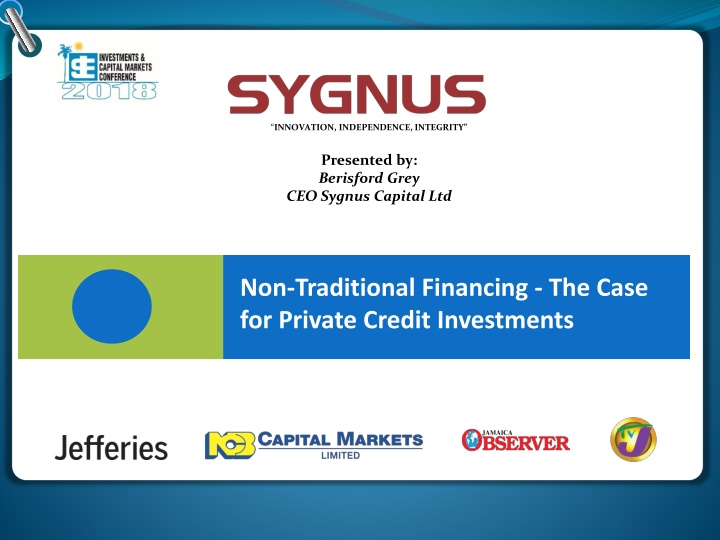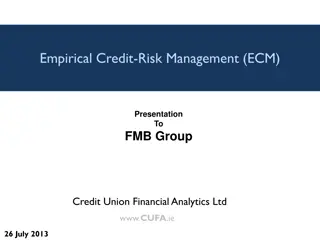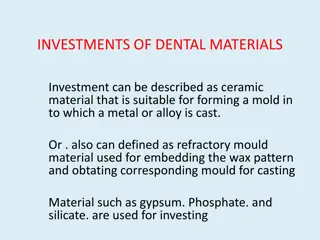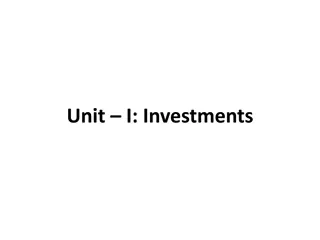The Case for Private Credit Investments in the Global Market
Private credit investments are gaining significance in the global market, offering innovative financing solutions outside traditional avenues like public markets. With a focus on innovation, independence, and integrity, private credit investments cater to diverse sectors such as real estate, natural resources, and infrastructure. Companies are attracted to private credit for its complex deal structures, partnership model, speed, agility, flexibility of terms, and the ability to tailor investments to match business strategies. The growth of private credit investments reflects a shift towards non-traditional financing models, driving substantial AUM growth and fostering long-term relationships with investors.
Download Presentation

Please find below an Image/Link to download the presentation.
The content on the website is provided AS IS for your information and personal use only. It may not be sold, licensed, or shared on other websites without obtaining consent from the author.If you encounter any issues during the download, it is possible that the publisher has removed the file from their server.
You are allowed to download the files provided on this website for personal or commercial use, subject to the condition that they are used lawfully. All files are the property of their respective owners.
The content on the website is provided AS IS for your information and personal use only. It may not be sold, licensed, or shared on other websites without obtaining consent from the author.
E N D
Presentation Transcript
INNOVATION, INDEPENDENCE, INTEGRITY Presented by: Berisford Grey CEO Sygnus Capital Ltd Non-Traditional Financing - The Case for Private Credit Investments
Private Market and Private Credit Investments (PCI): Definitions The Private Market is defined as closed-end funds investing in private equity, real estate, private credit / private debt, infrastructure, and natural resources. It excludes Hedge Funds and publicly traded open-end funds. Infrastructure Private Credit / Debt 02 01 Closed-end funds that invest in large-scale projects, excluding investments in public- infrastructure firms and listed funds Debt financing and bilateral credit from non- banks: direct lending, distressed debt, mezzanine debt, special situations & venture debt Natural Resources Real Estate 04 03 Closed-end funds that invest in real assets such as energy, agriculture/farmland, metals and mining, timberland, and water Closed-end funds that invest in property, excluding: direct holdings, listed real estate (REITS) and open ended funds Private Equity 05 Buyouts, Venture Capital, Turnaround and Growth Equity Source: :Prequin Global Private Debt Report
Global PCI Ecosystem Private Credit has the third largest AUM at a record $595bn (12.7%) within the $4.7 Tn Private Market, which is lead by Private Equity with $2.5Tn (53%) followed by Real Estate with $795bn (17%). 01 03 04 02 Record $595 bn AUM Private Credit AUM @ Jun 16 $93 Bn raised in capital Record $130bn Raised Record $100bn 11.4% CAGR Through 3Q of 2017 Capital distributed (dividends etc.) back to investors in 16 Growth Dec 10 to June 16 07 08 05 06 10 Consecutive Years Investor Location Source of Investments 4x Unbroken AUM growth since 2006, even during global credit crisis in 08 (up 20%) and 09 (up 14%) North America @58%, Europe @25%, Asia@ 9% Pension Funds @30%, Foundations @13%, Endowments @9%, Insurance Companies @9% AUM has quadrupled since $147bn in 06 Source: Prequin Global Private Debt Reports; Prequin Alternative Assets Performance Monitor
Why Companies Are Attracted TO PCI? Top four characteristics of private credit that firms value most: 02 01 03 04 Complex Deal Structures Ability to put together package that works in best interest of borrower as well as safeguard long term future of business; vs template structuring of traditional financing Partnership Model Speed and Agility Flexibility of Terms Long term relationship model to foster repeated business; board observation rights or board seats Speed combined with rigor and ability to finance in size; reduced layers of management structure and decision making for approval Investments are Structured to match business strategy; Use of customized structures - profit sharing, flexible amortization, higher LTV etc Source: Financing the Economy 2016 The Role of alternative asset managers in the non-bank lending environment Deloitte and AIMA. org
Why PCI is an Attractive Asset Class? The growth in Private Credit has been explosive due to the following reasons: Attractive Risk Adjusted Target Returns with Downside Protection 1 Attractive stable spreads above corporate, sovereign and high yield bonds; pays an illiquidity premium . US Private credit currently yields 8%+ currently, with 90% payout of earnings as distributions on a quarterly basis. Low Correlation with other Asset Classes 2 Generates positive alpha due to low correlation with traditional asset classes. Diversification across sectors, industries, strategies, and geographies. 3 Risk Reduction Generally stable performance across all market cycles. E.g. many US private credit managers are primed to benefit from gradually rising US interest rates due to underlying variable rate credit investments. Historically lower default rates and higher recovery rates than EM debt and bank loans. 4 Well established Asset Class Highly experienced fund managers with a wide menu of fund strategies and differentiated approaches. Viable alternative to traditional fixed income for fund managers seeking consistent stream of cash flow.
PCI Case Studies Sygnus Credit Investments
Case Study I: Sygnus Credit Investments CONVERTIBLE PREF. SHARE WITH PAYMENT-IN-KIND (PIK) Investment Size: J$580 Million Term: 5-years Date Closed: August 2017 Industry: Manufacturing Proceeds used to refinance debt & expansion Issuer benefited from increased cash flow due to interest only payments PIK feature enabled lower interest payments to boost profitability from higher cashflow reinvestment. Utilized Co-investor participation Double digit return to SCI and Co-investor
Case Study 2: Sygnus Credit Investments INVENTORY LINKED REPO NOTE FINANCING Investment Size: US$3.0 Million Date Closed: September 2017 Industry: Distribution & Manufacturing Proceeds used to fund working capital using Inventory Repurchase Agreement between SCI and Company Issuer monetized its inventory and improved its cash flow This innovative structure improved leverage ratios and profitability for the issuer Double digit return to SCI























